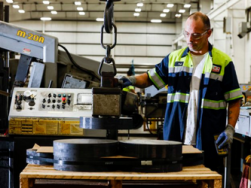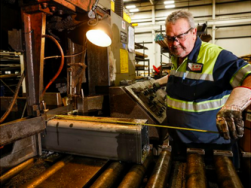State of Steel - August 2023
Pricing - Are we at the bottom or not? Uncertainty says... I don't know!
Structural tubing prices continued to decline over the 2nd quarter. Pricing is beginning to flatten out though due to the CRU index appearing to hit bottom. Structural tube pricing continues to be fluid and deals continue to be made in a competitive marketplace.
While structural tube prices have declined, mechanical tube prices have been flat. Lead times have shortened in the second quarter on DOM and CDS but not HRS. HRS tubing can be obtained on the spot market, but domestic sources are 30+ weeks behind on their product lead times. DOM Surcharges and fuel surcharges have dropped in the 2nd quarter and look to remain low going into the 3rd quarter.
The CRU index, which is an indication of where coil and sheet steel prices are heading, seems to have leveled off hovering from $820 to $885 per ton for the last 8 weeks. The CRU hit a low in December and since then seems to have peaked and then settled heading into the fall.



Cast Iron Pricing
There have not been any base price increases on cast iron since April 1st of 2022. Since May of 2023, Dura-Bar’s surcharges have seen a gradual decline in price and appear to remain flat going into the 3rd quarter. 
Scrap & Steel Inputs
Ahead of the August scrap buy week the outlook for scrap prices currently remains uncertain, although some market sources expect scrap prices to have reached a floor, with scrap collections in some regions currently as much as 50% lower month-over-month. Although a weak scrap export market could serve as an offset. (Source: Platts)
Metal Production
In the week ended July 22, US raw steel production increased 1.5% week-over-week to 1.741mt (+1.2% YoY). US capacity utilization was 76.6% vs 78.1% last year. This marks 53 consecutive weeks where capacity utilization has been below 80%. Year-to-date production is 49.362mt down 2.5% year-over-year from 50.641mt last year. (Source: AISI)
Lead Times
Understanding lead times for steel products is important to every participant in the supply chain. Lead times for steel products are as follows (as of 08/01/23):
DOM Tubing lead times have loosened up quite a bit. We are now anywhere from 6 to 12 weeks. Cold Drawn Seamless tubing has recently gone down as well and now stands at 10-18 weeks.
Structural Tubing mill lead times are low and run approximately 1-4 weeks upon receipt of order. Average HRC lead times were lower last week at 5.4 weeks, slightly below the long-term average since 2016 of 5.6 weeks. Other product lead times were flat to longer last week with CRC lead times at 6.9 weeks, HDG lead times at 7.1 weeks, and plate lead times at 6.0 weeks. (Source: Platts)
Dura-Bar Continuous Cast Iron mill lead times are shorter and approximately 1-3 weeks depending on size, grade, and finish. If it’s a large bar, special grade, size, or shape then the lead time could be longer.
Oil & Gas Industry
The US rig count decreased 0.9% week-over-week to 669 rigs as of 7/21. The rig count is down 11.7% year-over-year. (Source: Baker Hughes)
Economic Factors
US GDP rose at a 2.4% annualized pace in the second quarter, above analyst estimates of 2.0%. The personal consumption expenditures price index increased 2.6%, down from a 4.1% rise in the first quarter and below estimates of 3.2%, showing signs of abating inflation. (Source: CNBC)
The Fed last week raised its policy rate to the 5.25%-5.50% range, the 11th increase in the last 12 meetings.

Employment / Hiring
Approximately 0.221 million Americans filed for unemployment insurance last week. This was better than economists’ expectations of 0.235 million claims, and better than last week’s unrevised claims number of approximately 0.228 million claims. Continuing claims decreased during the week ending July 15 (continuing claims have a week lag in terms of reporting) and stand at approximately 1.690 million continuing claims. (Source: Reuters)
Imports/Exports
.png)
.png)






